MGCC – The Early Years
Although we have a newspaper report of a match played between Farnham and Matching at Farnham in July 1833, no other records have been found of the game.
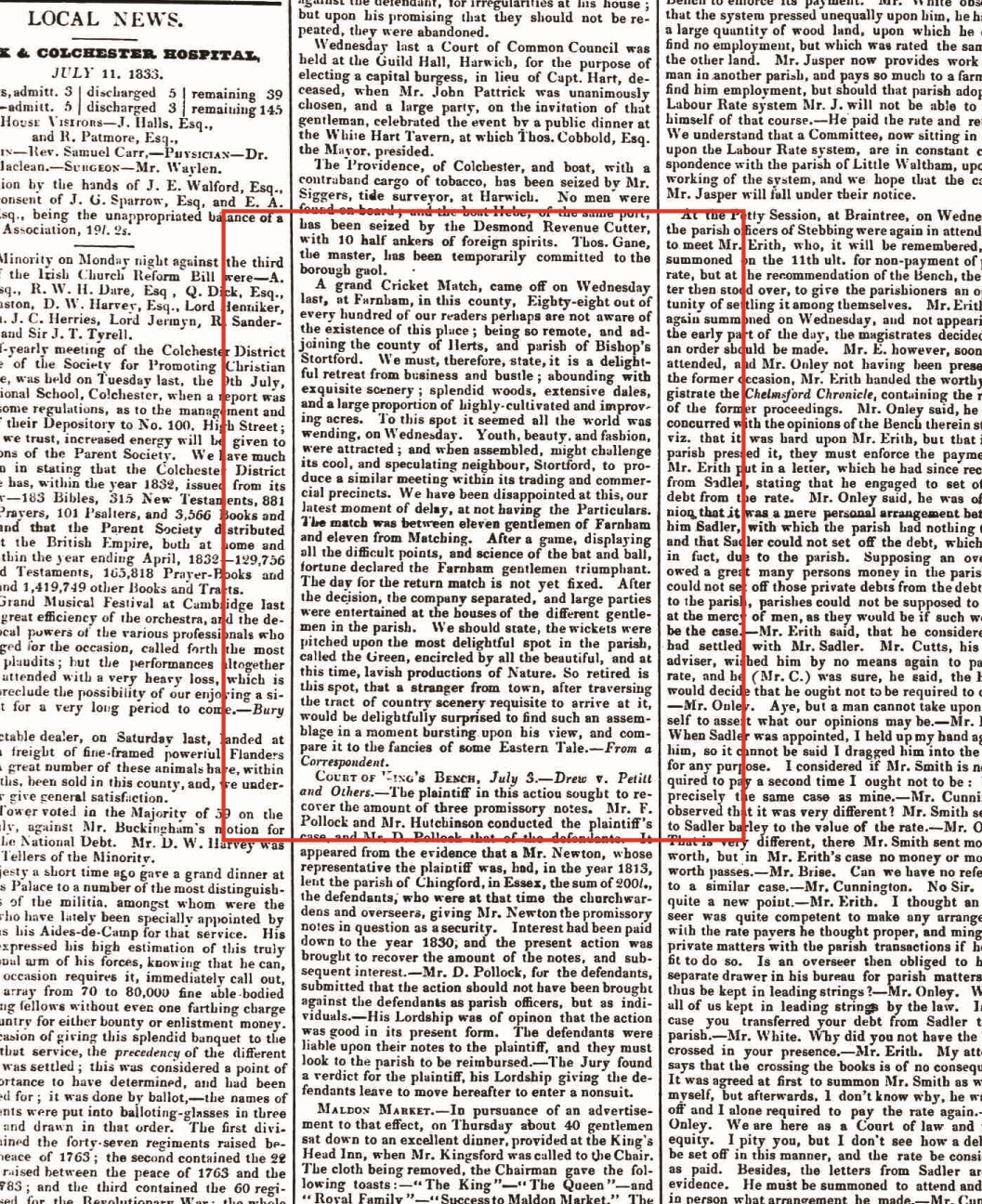
The earliest scorebook we've found (courtesy of our Vice-president Alan Howick) records a match played at Moor Hall between us and Moor Hall. Moor Hall was a large country estate between Matching Tye and Old Harlow.
The history of the Moor Hall Estate is mentioned in Domesday and influential families have lived there and played an important part in the Harlow community as figures of importance. Sadly there is nothing to be seen but farmland where the manor of Moor Hall once stood. During World War 2 the army took over the manor and estate. The foundations were weakened by the use of detonators in the cellar. Fire finally consumed the building in 1953.
John Perry Watlington (1823-1882) who inherited the family estate, was the local Magistrate and a generous benefactor to the community. Most importantly, he was a keen cricketer and formed the Moor Hall Cricket Club in 1850. A thatched pavilion was built on the parkland to the north of the house. In later years many famous cricketers were to play there. Each guest bedroom door bore a plaque with the name of great cricketer who had played on the ground.
One of Moor Hall's first matches was against Matching Green. The scorecard for the match played on 20th July 1850, clearly shows J. Watlington Esq. opening the batting for Moor Hall. It was clearly the right of the estate owner to open the batting! One notable name in the Matching Green team was Silcock. It's unclear which cousin this was, but Frank and Joseph Silcock were the star cricketers of their time. They played for many clubs in the area and represented The South of England. Further investigation of the records sees that Joseph resided in Matching Green at the time and was 18 years old on the date of the match against Moor Hall. With Frank just 12 years old at the time, it's reasonable to assume Joesph is the Silcock named in the scorebook.
The match itself was unusual (by today's standards) as it was a two innings match played in one day. There are no bowlers records so we can not tell how many overs were bowled. Nevertheless, the scorebook is fascinating reading. Moor Hall won the match by 52 runs.
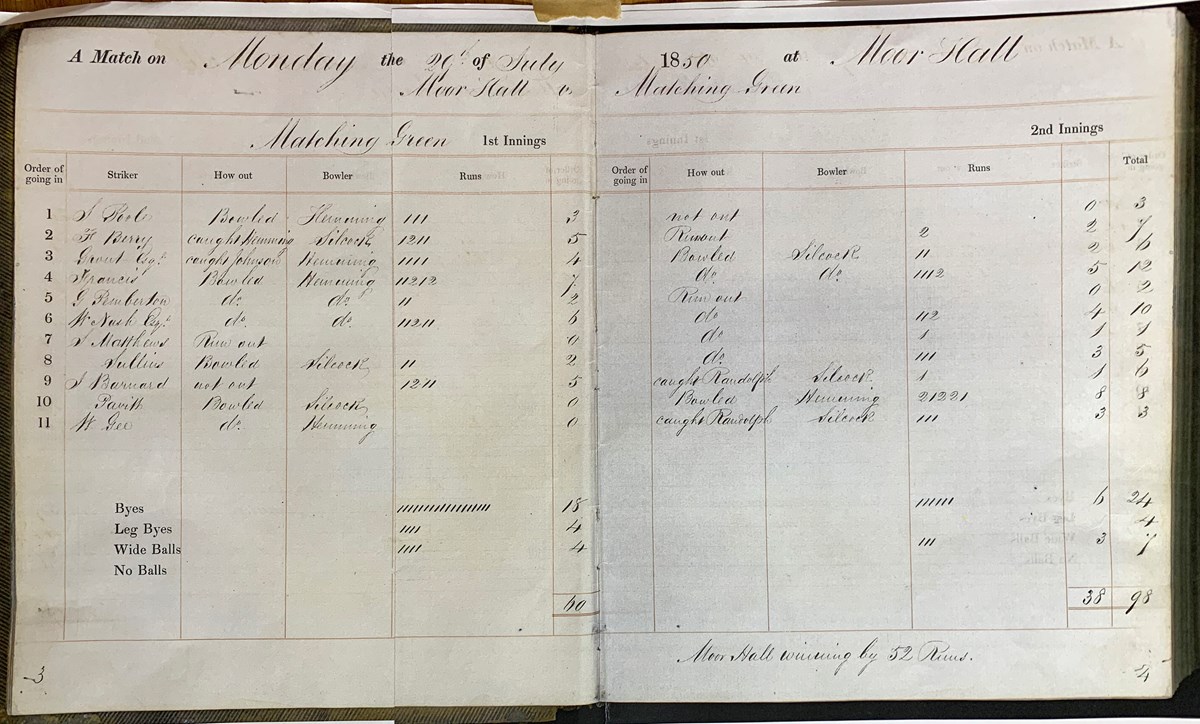
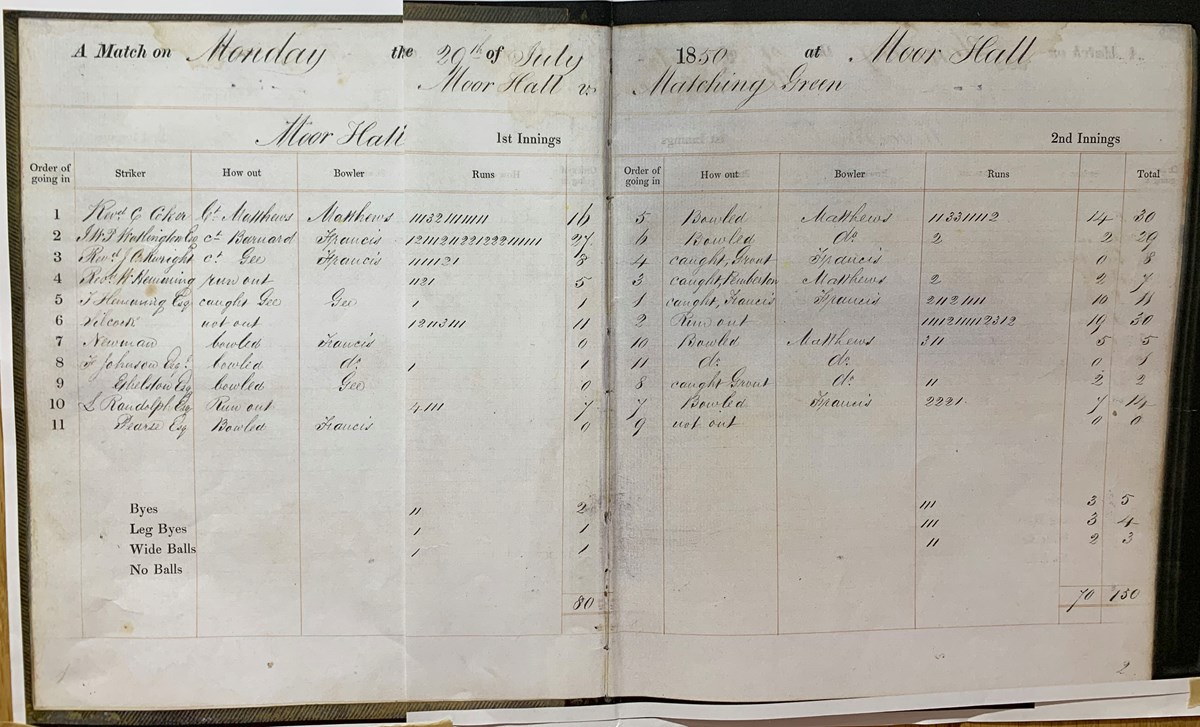
The Silcock Dynasty
Cousins Joseph and Frank Silcock were the star cricketers in the area in the late 1800's. Frank had the distinction of playing many times, both with and against W. G. Grace. The following extract, courtesy of Alan Howick, is taken from Alan's excellent 'Cricket in Harlow - The first 139 Years'. Another fascinating read and an insight into cricket life in the 1800's.
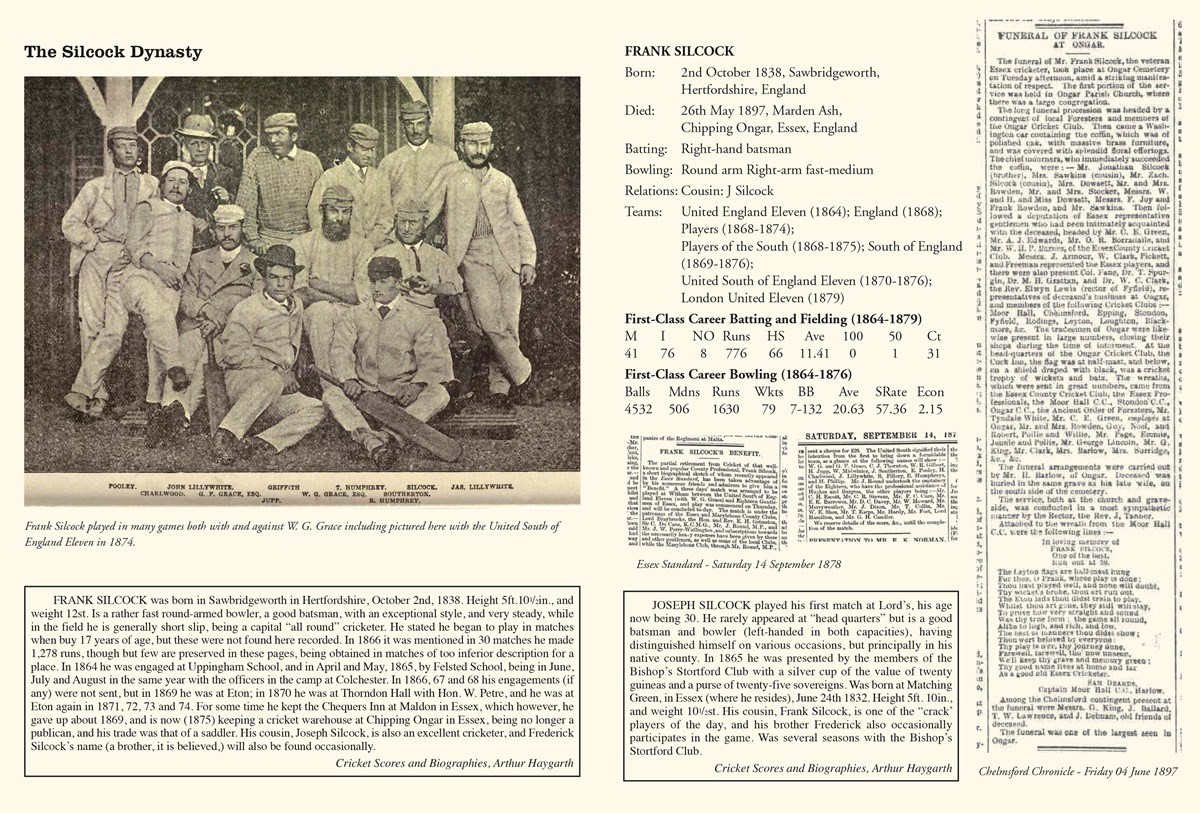
Cricket on Matching Green c. 1898
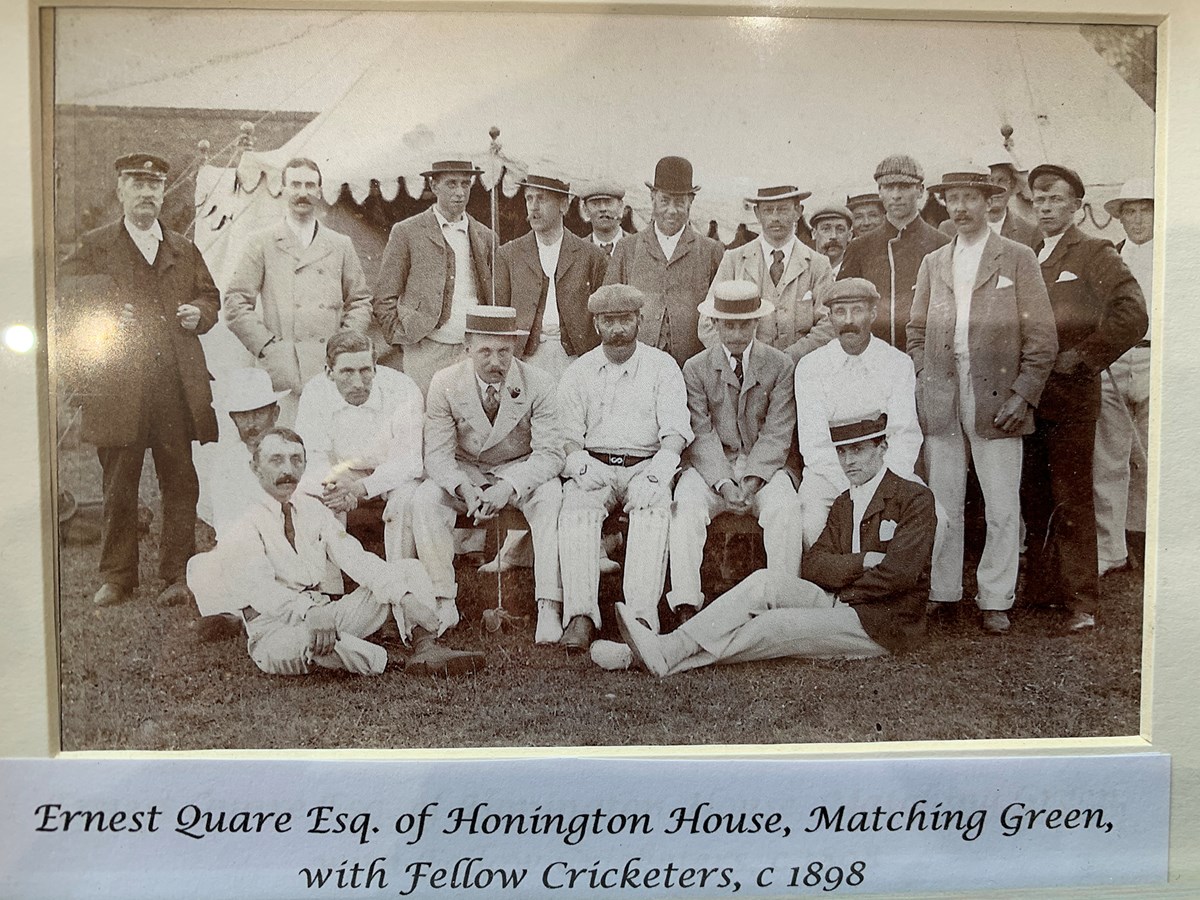
An interesting article courtesy of local historian Patrick Streeter
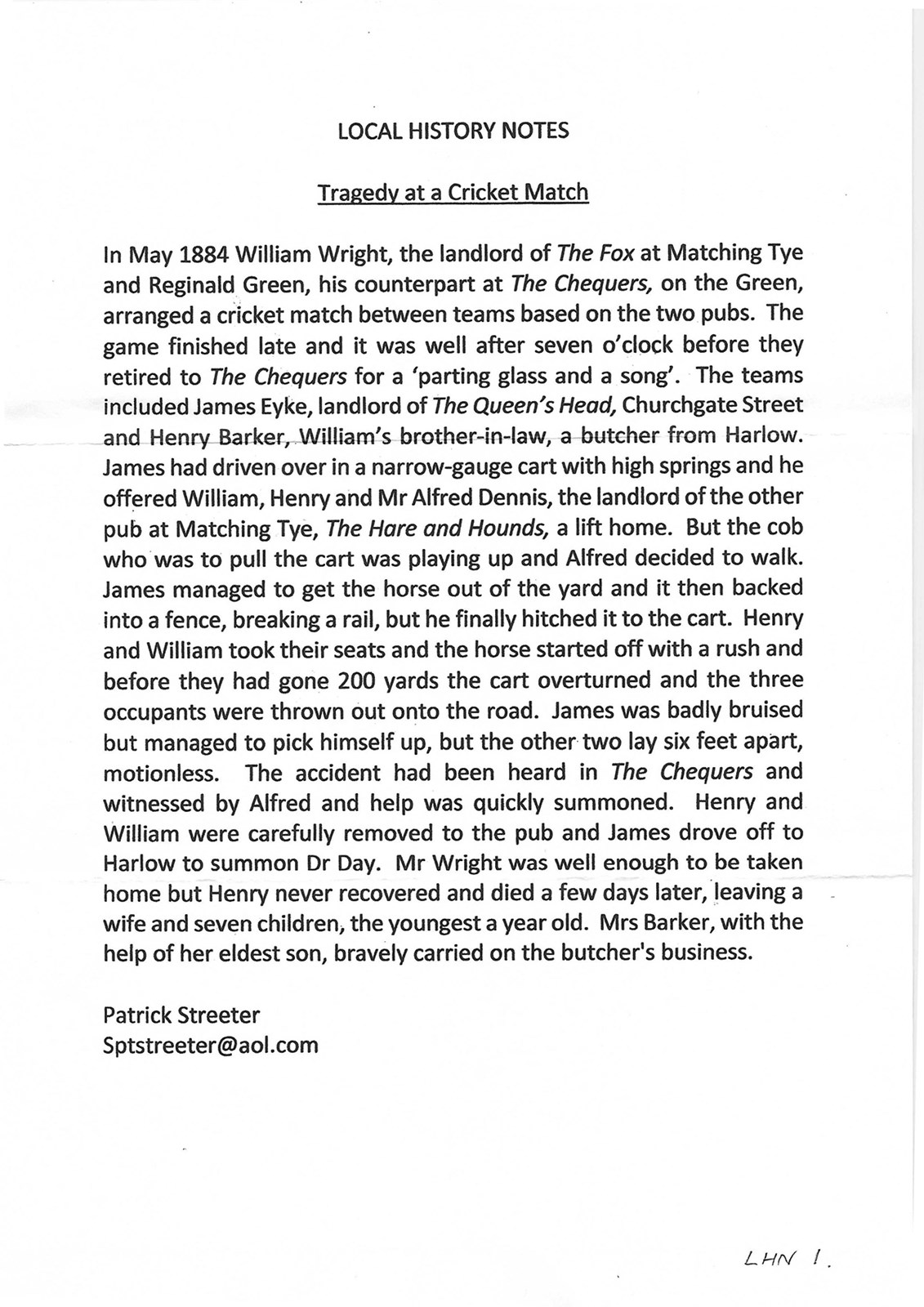
A fascinating glimpse of the past history of MGCC.
Written by Barbara Brown
Prepared for Website by Janice Hobbs.
CRICKET INTELLIGENCE
The following reports were taken from the Bishop Stortford Observer, dated 1862.
They make fascinating reading, as I am sure you will agree.
MAY 17th 1862 Matching Green v. Harlow
A match was played between these clubs on Tuesday last, at Matching Green. The ground was in first rate order and the weather was beautifully fine, just such a day as cricketers delight in. Amongst the Matching Green players were some cricketers not unknown to fame, including the brothers, S & J Silcock. It was hardly expected by any, and certainly not at all by the celebrities of the Green and their friends, that the Harlow players would prove the winners, but which they did, as will be seen by the score below of the first innings, which decided the game, as there was not time to play it out.
The Matching players were more successful I getting runs in their second innings, owing to the different fielding of their opponents, who appeared to be a little careless, as is often the case when a game cannot be played out for want of time, - those who have the game safe, play loosely. F. & J. Silcock did the damage for matching, and did it well too; S. Brace a young and promising cricketer, bowled remarkably well for Harlow, and he also batted and fielded well and shewed himself a cricketer at all points. Scott, backed and stopped well, and no byes was the result.
June 28th 1862 – West Essex v. Matching Green
On Thursday last, Mr. Meyer brought an eleven of the matching Club to play the West Essex at Navestock and mustering among his eleven more than one of the Silcocks, he evidently looked upon his victory as a certainty.
The West Essex however, joined as they were by the gallant artillarymen form Warley barracks, were also strong, and at the close of the first innings the matching seemed somewhat astonished to see the Telegraph announce but 41 to their opponents 98.
The Matching won the toss, but, wonderful to relate, elected to put their men out in the field first, Mr. Fane played a good innings of 51 and Messrs. Marshall and Basalgette ably assisted. For Matching, Silcock alone obtained double figures. Mr. Pattisson and Basham bowling in their very best form.
In the second innings of the West Essex, some very long scores were made, but suffice it to say that Mr Basham was here, Mr Basalgette there, Mr. Fane everywhere and Mr. Bond nowhere.
It appears that a curious incident happened to the Matching on their way home, which was that their bugler, in endeavouring to play their popular tune of “See the Conquering, etc” found the instrument rebellious, and involuntarily giving forth the more plaintive notes of “Oh dear what can the matter be”!
JULY 5th – 1862 – Matching v Dunmow
On Monday 30th, Mr. Wade brought an eleven of the Dunmow club on the Matching turf for a friendly game. The Dunmow won the toss, and of course handled the willow first, but owing to one or two emergencies picked up, and the bowling of Messrs. Fred Silcock and Brace being exactly on the spot, few runs were obtained, - suffice to say, Mr. Meyer played in his usual slashing form; while Mr. Wilson seemed intent in driving the ball through somebody’s windows and Messrs. Brace and Silcock in poking fun at the numerous ponds. The Dunmow followed their innings, but was again unable to make a stand, as one and all after being brought to “attention”, were quietly told to “stand at ease”.
July 22nd – Bishop Stortford vs. Matching Green
This match came off on Tuesday last, on the Stortford ground, and proved a rare treat to the lovers of a good game. Stortford went in first and succeeded in scoring 100 runs, and of which the two Spencers, A & B, scored 23 and 26 respectively, while
Mr. Bayliff made a good 18, which included a rattling “6”. Mr. Gee also made 8 very quickly, but our other friends were somewhat unfortunate. It will be seen that Frank Silcock succeeded in bowling no less than 9 of the wickets – being evidence of good play, as well as exhibiting the bowler’s well-known talent.
Matching then went in, and nobly did the Silcocks maintain the fame of their club, for out of the 161 runs obtained, they scored 94. Mr. Fane, the Rev. Mr. Wilson, and S. Brace, also gave the lookers-on a treat by their first rate play.
Bishops Stortford went in for their second innings, and when “time” was called, had made 88 runs with the loss of only 4 wickets: Mr. Percy Taylor getting 47 of the number in excellent style.
August 23rd – West Essex vs. Matching Green
This (return) match came off – or rather was to have come off had the weather been propitious – at Matching Green, on Thursday last, the 14th.
Play commenced son after 11:00, the West Essex winning the toss; but the ground, notwithstanding a liberal supply of water and a wet night, was certainly not calculated to show off good cricket. It is not very easy to do two things at once, and guarding one’s head and one’s wicket may be easy for some, and no doubt is geat fun for those who like it, but for those who do not it is quite another thing: Mr. Matthews seemed to think so, and was bowled in consequence. Mr. Cockerell got vicious – 30 was the result: Mr. Fane in trying to hit over the clouds found the ball too heavy, and matching seemed to think it might be hot so they left it alone; Mr. Fisher also tried a well-known Matching player with a catch or two, but as we have read before “A catch in the hand is worth two in the air”. 98 was the total. Mr. Groves & Mr. Izard were the first to represent the Matching, but alas Mr. Izard forgot “to run to Mr Fogo was certainly no go” and he retired. Pratt came next, but Rugby opposed and he fell a victim. F. Silcock soon waked up the field; he made some beautiful hits and was well in, when the rain which had all the day been threatening drove all to the tent, a soaking steady rain and a dark sky, 5 o’clock and it looked all over like a wet evening, so the West Essex decamped; hardly had they done so when the rain cleared off, and the Matching are supposed to have played the evening out, each man having provided himself with the very best goloshes, as after such heavy rain the ground must have been beyond a joke.
N.B. The Matching bugler could not be heard of, which is curious.
Apparently in the early 1870’s, Matching Tye had a team as well as Matching Green. The players often played f or both teams, though there is no record of the two teams opposing each other.
Leaving behind the 1860’s – 1870’s, in 1939 we had a replacement for the Silcocks, C. Holdgate, more affectionately known as Fringey. He played some excellent cricket, doing Matching proud.
For example in a game with Hatfield Broad Oak, Fringey took six wickets in the first innings and six wickets in the second innings, very impressive.Not so good batting, only 1 in the first and 3 in the second.
Again in May 1950 he was Man of the Match. Matching v LCC Parks, with bowling figures of 6-12 also the highest batting score of 23 runs.
Just a small taster of Fringey’s talent, we need more webspace to include the full extent of his conquests.
135 years ago, a beautiful day in summer, the players in their whites, the smell of freshly cut grass in the air, applause when a batsman was given out, how very relaxing, especially for the spectator. If only we had access to a time machine to travel back to relive those times. The wonderful realism is, the game hasn’t changed at all, cricket is enjoyed today just as it was then and, fingers crossed, will be for the next 135 years. A complete diversion to life in the 21st Century.
Then, at the close of play, everything changes, gone is the bugler extending the atmosphere of the game into the journey home by horse and cart, we return to our cars with our radios etc, back to our modern times, but take with us a small but beautiful piece of the past.
Barbara Brown
Current Club Overview - Winter 2005
For the last 100+ years cricket has been played on Matching Green. All matches were of a friendly type but this changed in 1995 when the club looked to the future and helped set up the Herts and Essex Observer League.
Matching Green were relegated down to Division Two in summer 2005 and for the first time in the club's history fielded a Saturday 2nd XI which won promotion from Division Six up to Division Five.
Graeme Bowerman led MGCC in the league this season and was forced to rely on schoolboys for most of the season to do the business for the 1st's.
For the 2nd's, Mr Martin Figg Esq skippered a formidable side sprinkled with a magical mix of youth and experience. Youngsters from our youth system learned many a lesson from old-pros such as T Bone and the Weaver. Colourful new characters filled the side of the likes of Danny Andrews, Mark Wilson and Paul Prowse.
We also had a full summer of 'friendly' matches which can and often are just as competitive as our league encounters.
Our Under 11 league side enjoyed a superb first league campaign ending with a final fixture at the County Ground, Chelmsford which the young lads will never forget.
We are planning to build a new pavilion on the Green. Planning consent has already being approved after going to appeal. Fundraising has already started and we hope to start work on the project before too long.
SJH.
2013
Surely the biggest year in the club's long history. After a long protracted 12 years we eventually built our new pavilion, and wow!! Was it worth the wait? Larger all round with nice changing rooms, individual showers for each team, a stunning kitchen, more space for tea, storage for all our equipment and all mod cons. A fantastic building which should serve the club well for the next 50 years.
To cap the new pavilion, what better way to celebrate than to win the league in the same year, the first time the club have achieved this feat since joining the league in 1995.